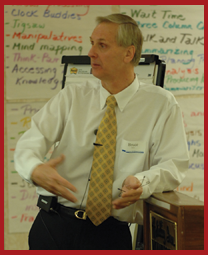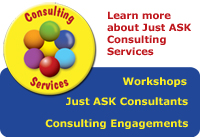
September 2017
Volume XIV Issue IX
Share this newsletter
Introspection: Timely Options for Reflection

Bruce Oliver, the author of Just for the ASKing!, lives in Burke, Virginia. He uses the knowledge, skills, and experience he acquired as a teacher, professional developer, mentor, and middle school principal as he works with school districts across the nation. He has written more than 150 issues of Just for the ASKing! He is also a co-author of Creating a Culture for Learning published by Just ASK.
As educators, many of us do not take the time to think deeply about the work we do. We simply do our jobs without consciously reflecting on the impact we have, or how our behavior can affect those around us. Maybe subconsciously an occasional thought will enter our minds but it will be fleeting and soon we are back to carrying out our responsibilities. If we took more time to analyze our actions, we might be better at our jobs, and be more in tune with others.As educators, many of us do not take the time to think deeply about the work we do. We simply do our jobs without consciously reflecting on the impact we have, or how our behavior can affect those around us. Maybe subconsciously an occasional thought will enter our minds but it will be fleeting and soon we are back to carrying out our responsibilities. If we took more time to analyze our actions, we might be better at our jobs, and be more in tune with others.
I recently heard a speaker talk about the mental health benefits of taking some private time to contemplate our style of behavior. His thesis was that we could become better people by looking inside ourselves and mulling over some questions that deal with our actions. This issue provides some options to consider when you want to be reflective.
Have you expressed gratitude to those who helped you get where you are today?
At a recent breakfast at which college scholarships were announced, a past scholarship recipient was the keynote speaker who returned to tell his audience how much that scholarship meant to him so many years ago. His message was clear: Gratitude is just a passing thought until you take the time to share your indebtedness with those who impacted your life. He encouraged his audience to take stock of others who have helped them or who are continuing to help them reach a career goal. Whether it is in a face-to-face conversation or a written note, expressing your thankfulness to another person can be rewarding for both parties.
Have you recently called parents or guardians with good news?
Educators are often required to contact parents or guardians when students exhibit poor or disruptive behavior, or when they are not putting forth effective effort. These encounters can be unpleasant for both parties since parents do not relish getting bad news about their children, and educators must be diplomatic but honest when they are delivering bad news. Some teachers (and administrators) make it a regular practice to set aside time specifically to make calls with good news. These calls are especially important when a student has shown growth in an area that has previously been troublesome. Parents are often caught off guard and have a positive emotional reaction when they receive these calls. These are the messages they will treasure long after their child’s educational years are completed.
Do you bring a positive attitude to your job?
Our actions, our demeanor, and our words set the tone for how our lessons will be received by our students and colleagues. Something as simple as a smile or a friendly greeting conveys to our students that we are glad to be there and their attendance is important to us. Responding to a student’s participation with an encouraging remark, injecting humor into our lessons, or sharing a personal story can also endear a teacher to the children they teach.
Are any of your students or colleagues your heroes? Have you told them?
A speaker recently posed the above question and it was well received by her audience, but also a question that few of those in attendance had considered. There are children who are seated before us who are facing adversity that we would have found impossible to endure when we were young. We may have encounter students or adults who have done extraordinary or difficult things to support their family members or fellow students or colleagues in unexpected ways. We may hear about these situations or exploits, and reveled privately knowing that a youngster or adult with whom we work has overcome a difficult situation or showed compassion to another person. But have we taken the next step and told these individuals how proud we are of them or how much we admire what they have done? The speaker urged audience members to make sure to take the time to look these brave individuals in the eye and tell them in a heartfelt way how much we are moved by their actions. It will likely have a huge positive impact on their self-concept and help them to remember that we care deeply about them.
Are you a good listener?
There are some people whose thoughts move to what they will say in response to another person’s ideas rather than listen fully to a peer’s words. There are also other individuals whose facial expressions and body language indicate that they are “elsewhere” and not truly attentive. True communication is not simply talking; listening makes communication complete. Many of us want to be good listeners but we may not have thought about what constitutes genuine listening. As Forbes magazine contributor Dianne Schilling wrote, “In today’s high-tech, high-speed, high-stress world, communication is more important than ever, yet we seem to devote less and less time to really listening to one another.” Compare your listening skills against the steps she suggests that will help to make us more genuine and successful communicators:
- Face the speaker and maintain eye contact.
- Be attentive, but relaxed.
- Keep an open mind.
- Listen to the words and try to picture what the speaker is saying.
- Don’t interrupt and don’t impose your “solutions.”
- Wait for the speaker to pause to ask clarifying questions.
- Ask questions only to ensure understanding.
- Try to feel what the speaker is feeling.
- Give the speaker regular feedback.
- Pay attention to what isn’t said – to nonverbal cues.
Finally, remember that it is just as important to be a good listener to your students They will not only respect you for truly hearing them but they will grow to be better listeners as they grow older.
What stories will you tell about your career in 30 years?
During a recent get together with veteran and retired educators, the conversations were filled with many stories from the past. As typically happens, the tales invoked a myriad of responses including, “What was I thinking?” to “We always laugh every time someone retells that story” to “Despite my youthful naiveté, I think things turned out all right for my students” to “I’m glad I paid attention to the experienced teachers because I could feel myself getting better and better over time.” As one person noted, “Aren’t we all glad we survived long enough to tell these stories.” What is interesting is that many of the stories had comic overtones. All in all, most of the people did not focus on mishaps but remembered the good things that happened. I am willing to bet that some of your favorite remembrances will focus on some seemingly small things that others did for us which turned out to make a significant difference. Don’t wait too long to collect those important memories!
Are you proud of your skills as a collaborator?
Let’s begin with a clear-cut definition of collaboration. One of the best definitions comes from brighthubpm.com: “Collaboration joins the efforts of team members to share their perspectives and opinions to create an expanded vision of the problems or mission at hand. This effort should produce solutions and achievements that are greater than anyone could produce individually.” The question then becomes: Do our collaborative efforts match the definition above? Typically groups or pairs get together (sometimes voluntarily, sometimes imposed), they follow an agenda (if there is one), and occasionally they might leave with a new idea or plan (sometimes by design, sometimes by accident). It is perhaps uncommon for groups to discuss or examine how they do business or how to get the results they want from their collaborative efforts. The website Study.com provides an examination of some of the ABC”S of basic collaborative skills which include:
- We must believe in and commit ourselves to working with others
- We must accept the responsibility of joining in the conversations and not simply be a bystander (“bysitter”)
- We must be open to other’s opinions
- We must practice how to effectively begin and end a conversation
- We must be willing to ask for help
- We must ask questions if we are curious or confused
- We must express our true feelings or concerns
- We must give compliments or provide constructive criticism
One of the most important collaborative strengths is the ability to negotiate or compromise when necessary. These skills take us back to the reason we get together in the first place: To provide an expanded view of the problem or mission at hand. Now ask yourself: Do the groups I work with exhibit fruitful collaborative competence? If not, maybe they should begin their next session with a review of productive collaborative skills. Only then will they be able to model those competencies when they are working with students.
Do you inspire creativity among your students?
There is nothing more inspiring than to walk into a classroom that is filled with excited voices, lively conversations, enthusiastic involvement by everyone, and an overall stimulating topic under discussion. At the other end of the spectrum is a classroom where one person (most often the teacher) is sharing information, explaining a process, teaching a new concept or demonstrating a technique. Both of these descriptors are valuable and necessary. Letting go of being the most important source of learning is a difficult step for many educators to take. However, in our 21st century settings it is a quintessential step to take if we have the best interest of our children at heart. To instill creativity within our young people, we should create lessons or scenarios that require or encourage students to question assumptions, take risks, and recognize the reality of making mistakes. As students work together, the role of the teacher is to reward and encourage unique ideas and products, and emphasize that delayed gratification is a part of the creative thinking process. Writers Robert Sternberg and Wendy Williams conclude in their article, “Teaching for Creativity: Two Dozen Tips;” Small changes in the way questions are asked, assignments are worded, and tests are crafted can make a big difference in the lives of students.”
Are you taking time to notice those who may need your attention or support?
Once that opening bell rings, we are off and running. It sounds like the stock exchange but, in actuality, it is the beginning of the school day. Education is one of those professions where the adult is on stage almost continually doling out directions, assignments, and wisdom. One really has to live it to fully understand that teaching is a challenging job. Whereas our primary responsibility is to impart knowledge and skills, what cannot be denied is the human factor. There are thousands of children who sit before us each day whose needs extend far beyond the curriculum. Teachers are in the unique position to be able to get to know their students on a personal level. Some function just fine while others are in desperate straits and need further attention. Our jobs transcend lesson plans, answering questions, grading papers, and keeping order. We must be vigilant and be on the lookout for the individual who is scared, lonely, distracted, sometimes rebellious, and who is often experiencing chaos in their lives outside the classroom. Our “teacher radar” must be on the lookout for these needy children, reach out to them, break down any communication barriers, and be the empathic adult who can provide the understanding that can lead these individuals to a better place.
What do you think your past students will say about you?
The reality is that we will probably never truly know how our students felt about being in our lives. On occasion, we might receive a card, a note or a small gift. Some students may express how they feel in a brief face-to-face conversation while others may have difficulty expressing their feelings and simply give us a big smile. There are certain behaviors that children and adults comment on as they think about their favorite classroom experiences. They remember the teacher who made learning interesting and fun; they recall the passion and energy an adult included in her delivery; they recollect the stories their teacher told, especially those that revealed personal information or the admittance of learning from a mistake when they were younger. Some students also reminisce about the respectful way their teacher helped them or the way they were treated as an individual and not just another member of the class. Some former students also remember the adults who were good classroom managers but who were willing to bend the rules when it was necessary. Finally, many former students remember small events or interesting details/lessons that resonated with them but have long since been forgotten by their teachers. There are a lot of children whose lives we touched who will have strong positive memories of their times with us.
What reveals the professional learning you have gained and used in your work?
In any profession, it is important to keep an open mind, to be willing to entertain new ways of thinking, and to incorporate innovative practices into their work. In many of today’s jobs, change is constant, and if one is to be successful, standing pat is a definite deterrent. Teaching should be thought of in the same way. Updating one’s skills, developing repertoires to help all students learn, and letting go of stale or outmoded practices should all be a part of a teacher’s reality. One way for an individual to determine if he has made progress in his career is to make a comparison to the methods and procedures he used at the beginning of his profession and itemize the specific beliefs, actions, and attitudes that are different from the way he began. It can be a worthwhile and healthy undertaking to reflect on your growth as a true professional.
What have been your proudest moments in your educational career?
Perhaps you will think about your day-to-day preparedness, your on-going adaptability, your proactive behavior to solve a potential problem, your ability to be an effective communicator both with your students and your colleagues, the compassion and respect your showed the students under your care, and the times you extended yourself to help another person. Most likely, however, your memories will include the little things that are stored in the back of your mind that you will suddenly recall. You will probably picture faces, relive events, and recall scenarios that will bring a smile to your face. I am willing to bet that most of your proud moments involve building and sustaining relationships. My wish is that as you reflect you are filled with happiness.
As I reviewed the options explored in this newsletter, I thought of the different ways the questions could be used. They might be part of a community builder in a workshop, or a way of beginning a faculty or team meeting, or simply to think about in a quiet moment when you are not undertaking one of your many responsibilities. However you may choose to think about the questions, I hope they bring you satisfaction and fulfillment.
Resources and References
Schilling, Dianne. Forbes. November 9, 2012.
www.forbes.com/sites/womensmedia/2012/11/09/10-steps-to-effective-listening/
Sternberg, Robert and Williams. “Teaching for Creativity: Two Dozen Tips.” The Center for Development and Learning, January 2003.
www.cdl.org/articles/teaching-for-creativity-two-dozen-tips/
Tyson, Bruce. “Characteristics of Effective Collaboration.” Bright Hub Project Management, May 19, 2011.
www.brighthubpm.com/resource-management/70714-characteristics-of-effective-collaboration/
Permission is granted for reprinting and distribution of this newsletter for non-commercial use only. Please include the following citation on all copies:
Oliver, Bruce. “Introspection: Timely Options for Reflection” Just for the ASKing! September 2017. Reproduced with permission of Just ASK Publications & Professional Development. © 2017. All rights reserved. Available at www.justaskpublications.com.



